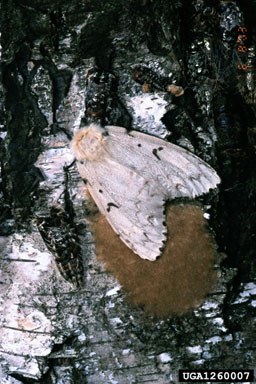Posted: November 7, 2024

Spongy moth laying eggs. Photo credit: Hannes Lemme, Bugwood.org
Pennsylvania Woodland Owners: Preparing Now for Spongy Moth Emergence in 2025
With the current spongy moth outbreak expected to continue, many of Pennsylvania's forest landowners are preparing for the 2025 season.
Last spring, many trees and forests were defoliated by spongy moths. Repeated defoliation will impact tree health, leading to tree death, costly tree removals, and loss of ecosystem services provided by trees and forests.
Penn State Extension, the PA Department of Conservation and Natural Resources (DCNR) Bureau of Forestry, local communities, organizations, and others are currently hosting public meetings and providing information and resources to help landowners make informed decisions in preparation for the spring 2025 spongy moth caterpillar emergence. Check now for a meeting near you—waiting until the weather warms to take action can be too late to treat. Your county’s DCNR Bureau of Forestry service forester or Penn State Extension office may have information about upcoming meetings. Penn State Extension (https://extension.psu.edu, type “spongy moth” in the search bar) and the PA DCNR (https://www.dcnr.pa.gov/Conservation/ForestsAndTrees/InsectsAndDiseases/SpongyMoth/Pages/default.aspx) have a host of information and resources to assist forest landowners.
In our Winter 2024 issue of Forest Leaves, we featured excerpts from a Penn State Extension article on counting egg masses during the fall and winter months to determine if conditions warrant consideration of aerial spraying. Read the full article here: https://extension.psu.edu/guide-to-spongy-moth-egg-mass-surveying.
James C. Finley Center for Private Forests
Address
416 Forest Resources BuildingUniversity Park, PA 16802
- Email PrivateForests@psu.edu
- Office 814-863-0401
- Fax 814-865-6275
James C. Finley Center for Private Forests
Address
416 Forest Resources BuildingUniversity Park, PA 16802
- Email PrivateForests@psu.edu
- Office 814-863-0401
- Fax 814-865-6275

